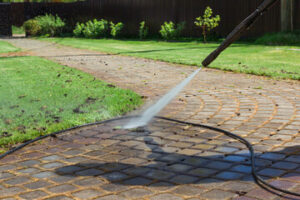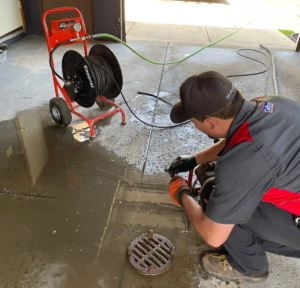Power washing, also known as pressure washing, is a powerful and transformative solution for cleaning and refreshing home and commercial exterior surfaces. Combined with the right cleaning solutions and lower pressure techniques, it removes oil stains, mildew, algae and more.

It’s vital for maintaining a clean and inviting appearance of commercial properties, which impacts customer loyalty and satisfaction. It also prepares surfaces for painting and staining by removing loose paint and dirt. Visit https://www.certifiedsoftwash.ca/ to learn more.
When you want to increase your home’s curb appeal, a clean exterior is key. It’s also one of the most cost-effective ways to improve your property’s value, especially if you plan to sell it later. Hiring a professional power washing service to handle this heavy-duty cleaning saves you weeks of scrubbing, mixing cleaner solutions in a bucket and climbing on ladders. It’s also safer than doing it yourself, as DIY power washing can be dangerous if you don’t have proper equipment and know-how.
Professional power washing services use specialized nozzles and attachments to adjust the water pressure to avoid damaging different types of surfaces. They also pre-treat stains, select the right water temperature and use a sweeping motion to effectively clean without harming the surfaces being cleaned. This eliminates the need for harsh chemicals, which are also less environmentally friendly. Additionally, professional services use biodegradable and non-toxic cleaning solutions that are safe for your plants, animals and kids.
A clean exterior doesn’t just make your home or business look better, it helps maintain structural integrity and prevents damage from accumulated pollutants like dirt, mildew, mold, and loose paint. Establishing a regular cleaning schedule with power washing services keeps your exterior clean, helping you save money on costly repairs in the future. And, for commercial properties, a clean exterior is essential in creating a positive first impression on potential customers, boosting customer satisfaction and retention. A professional power wash will help you make a great first impression every time.
Commercial
Power washing is the cleaning method of choice for commercial spaces that need a thorough, yet quick clean. Parking lots, building siding, brick pathways and other surfaces on and around businesses and commercial properties become grimy and covered in oil stains, gum and graffiti over time. Regular cleanings help to maintain surfaces and extend their life, and can also improve the overall appearance of a property.
Experienced cleaning technicians know that choosing the right pressure, temperature and nozzle for the job is important to avoid damage to sensitive surfaces such as pavers, wood and concrete. Cleaning solutions can also be added to the heated water to aid in sanitizing and cleaning commercial surfaces.
The best power washing services will be able to work with your schedule to perform cleanings when they are least disruptive to your business. The team should be able to come in before you open or after you close so that they do not interfere with your day-to-day operations. They should also be able to provide you with a quote upfront that covers all the fees and charges so there are no surprises when it comes to paying the bill.
A clean and well-maintained exterior is just as important for a business as it is for a home. Power washing services can help keep your business looking its best, and can make a great first impression on customers and guests. Regular maintenance can also help to extend the life of your exterior paint, and can protect your investment and your brand image.
Concrete
Concrete surfaces are a major part of many properties and undergo considerable wear and tear. Over time, this can lead to the accumulation of grime, oil stains, mold, mildew and other contaminants. Regular cleaning and maintenance with power washing services helps prevent this build-up and keeps your concrete looking clean, new and attractive.
While sweeping and occasional applications of a degreaser can go a long way in keeping your concrete looking good, a power wash is necessary to really get the job done. A professional power wash service uses specialized equipment to blast away stubborn dirt, grease and oil that have built up on your concrete surfaces. Using the right water pressure, detergents and surface cleaners, a power wash can really make your concrete look like it was just installed.
Power washing is also a great prepping tool for applying sealants or coatings to your concrete surfaces. This helps to ensure a better bond and prevents the substances from peeling or flaking over time. In addition, a thorough power wash can reveal any cracks or damage to the concrete that may require repairs before applying protective sealants.
While it’s possible to DIY power washing, only professionals have the equipment and know how to use it safely and effectively. Improper usage of a power washer can cause damage to your property or even personal injuries. Professional power washing companies take safety seriously and know how to minimize the risk of damage. They start by assessing the area to determine if power washing is appropriate and if there are any areas that should not be cleaned with this method. In addition, they only use biodegradable cleaners that will not harm plants or the surrounding environment.
Decks & Patios
The right power washing team can bring a new life to your deck and patio. It’s an affordable way to make your outdoor spaces look like they’re brand new, and it can also help prolong their lifespan. The dirt and organic buildup that accumulates on wood surfaces can cause them to rot, crack, or split, but regular cleaning removes it and preserves their integrity.
A clean deck and patio are more inviting to guests and can make your home feel bigger and brighter. It’s a great idea to get your surfaces cleaned before you entertain, especially because dirt, mildew, algae, and other contaminants can be slippery and lead to accidents on the deck. Regular cleaning also makes it easier to spot problems, such as sagging boards or cracking concrete, so that you can make repairs before they become a major problem.
While power washing can be a great solution for concrete and other surfaces that can handle high pressure, it’s not the best option for wood. The force of the water can disturb and damage the delicate fibers in wood, causing them to stand up and create an unsightly texture called “fuzzies.” Soft washing deck & patio cleaning services use a lower-pressure approach that uses safer cleaners to get the job done without damaging your outdoor surfaces.
When it comes to preparing your deck for the Fourth of July, you can’t go wrong with a professional soft washing deck & patio cleaning service. This gentle, low-pressure cleaning method uses safe and effective cleaners to penetrate deep into the algae and dirt that stain your deck, restoring its natural beauty before your backyard barbecues. It’s also an ideal choice for getting your deck ready for a new coat of stain, as it eliminates any leftover grime and prepares the surface for a smooth application that will last longer.
Outdoor Furniture
Outdoor furniture plays a crucial role in creating inviting patios, decks, and garden nooks for entertaining or relaxing. However, over time, these pieces can become covered in dirt, grime, mildew, and mold, detracting from their appearance and diminishing their comfort. A regular power washing process helps eliminate these unsightly build-ups and restores outdoor furniture to its original condition, making it an attractive focal point for any garden or yard.
A well-maintained outdoor living space is an integral part of any home. Maintaining the condition of patios, decks, and other outdoor furniture is essential for ensuring the safety and enjoyment of family members and guests. Regular power washing helps eliminate hazards caused by slippery surfaces or the growth of mold and mildew.
Whether your outdoor furniture is made of wood, metal, or plastic, a regular power washing process can help prolong its lifespan and enhance its beauty. Unlike traditional cleaning methods, power washing uses high-pressure water jets to effectively remove embedded dirt and debris without the need for harsh chemicals or abrasive scrubbing. Professional power washing services also have the expertise to adjust pressure settings to suit the surface and material of your furniture, preventing damage or discoloration.
Investing in long-lasting and visually timeless furniture is a smart move for any homeowner. When shopping for new outdoor furniture, look for items made from durable materials like natural teak or stainless steel. Additionally, it’s best to invest in furniture that is outfitted with removable cushions for periodic airing, cleaning, and repair. Similarly, it’s a good idea to purchase outdoor furniture that is manufactured with environmentally-conscious fabrics like acrylics, polyester, or treated canvas. Finally, be sure to store outdoor furniture in a garage or shed during off-season or rainy months to prevent weather-related damage.


